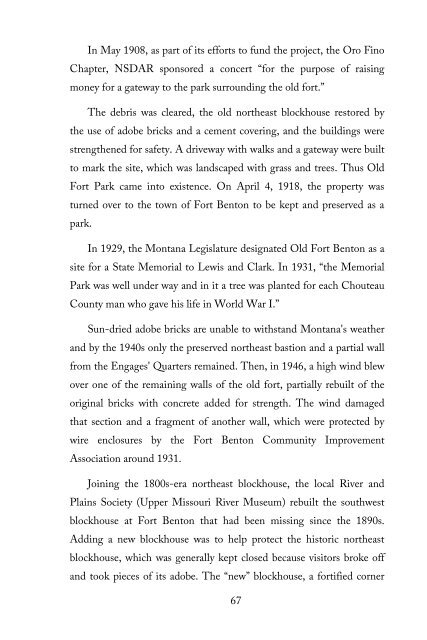Montana's DAR Markers . . . Honoring Where History Was Made
This book is a 200-page thank you to the women of Montana State Society Daughters of the American Revolution for their work in placing historical markers across the state of Montana. Starting in 1908, Montana DAR has installed 70 historical markers across the state. Of those, 33 remain. This book records why the markers’ sites were selected, their history, and the backstory of each.
This book is a 200-page thank you to the women of Montana State Society Daughters of the American Revolution for their work in placing historical markers across the state of Montana. Starting in 1908, Montana DAR has installed 70 historical markers across the state. Of those, 33 remain. This book records why the markers’ sites were selected, their history, and the backstory of each.
You also want an ePaper? Increase the reach of your titles
YUMPU automatically turns print PDFs into web optimized ePapers that Google loves.
In May 1908, as part of its efforts to fund the project, the Oro Fino<br />
Chapter, NS<strong>DAR</strong> sponsored a concert “for the purpose of raising<br />
money for a gateway to the park surrounding the old fort.”<br />
The debris was cleared, the old northeast blockhouse restored by<br />
the use of adobe bricks and a cement covering, and the buildings were<br />
strengthened for safety. A driveway with walks and a gateway were built<br />
to mark the site, which was landscaped with grass and trees. Thus Old<br />
Fort Park came into existence. On April 4, 1918, the property was<br />
turned over to the town of Fort Benton to be kept and preserved as a<br />
park.<br />
In 1929, the Montana Legislature designated Old Fort Benton as a<br />
site for a State Memorial to Lewis and Clark. In 1931, “the Memorial<br />
Park was well under way and in it a tree was planted for each Chouteau<br />
County man who gave his life in World War I.”<br />
Sun-dried adobe bricks are unable to withstand <strong>Montana's</strong> weather<br />
and by the 1940s only the preserved northeast bastion and a partial wall<br />
from the Engages' Quarters remained. Then, in 1946, a high wind blew<br />
over one of the remaining walls of the old fort, partially rebuilt of the<br />
original bricks with concrete added for strength. The wind damaged<br />
that section and a fragment of another wall, which were protected by<br />
wire enclosures by the Fort Benton Community Improvement<br />
Association around 1931.<br />
Joining the 1800s-era northeast blockhouse, the local River and<br />
Plains Society (Upper Missouri River Museum) rebuilt the southwest<br />
blockhouse at Fort Benton that had been missing since the 1890s.<br />
Adding a new blockhouse was to help protect the historic northeast<br />
blockhouse, which was generally kept closed because visitors broke off<br />
and took pieces of its adobe. The “new” blockhouse, a fortified corner<br />
67





